Contents
Introduction
A growth mindset is the belief that abilities and intelligence can be developed with dedication, hard work, and the right strategies.
This concept contrasts with a fixed mindset, where individuals believe their talents and abilities are static and unchangeable. The term “growth mindset” was coined by psychologist Carol Dweck, who conducted extensive research on the impact of mindset on success and personal development.

In this article, we discuss the concept of a growth mindset, its benefits, and how it contrasts with a fixed mindset. We explore ways to develop and maintain a growth mindset, its impact on personal and professional life, its integration with clinical psychology, and strategies to foster a growth mindset in others.
Characteristics of a Growth Mindset
Individuals with a growth mindset are open to learning and feedback. They actively seek opportunities to expand their knowledge and skills. Constructive feedback is seen as valuable information that can guide their development. They are not defensive about criticism but use it to improve and grow
Difference Between Growth Mindset And Fixed Mindset
| Aspect | Growth Mindset | Fixed Mindset |
| Belief about abilities | Abilities and intelligence can be developed | Abilities and intelligence are static and unchangeable |
| View on challenges | Embraces challenges as opportunities to grow | Avoids challenges to prevent failure |
| Response to obstacles | Persists in the face of setbacks | Gives up easily when faced with obstacles |
| Criticism | Learns from criticism and feedback | Ignores or resents constructive criticism |
5 Benefits of Adopting a Growth Mindset
Adopting a growth mindset can be transformative, unlocking new levels of personal and professional development.
Unlike a fixed mindset, which views abilities as static, a growth mindset embraces challenges and sees failures as opportunities for learning. This shift in perspective can lead to numerous benefits, fostering resilience, enhancing creativity, and driving continuous improvement.
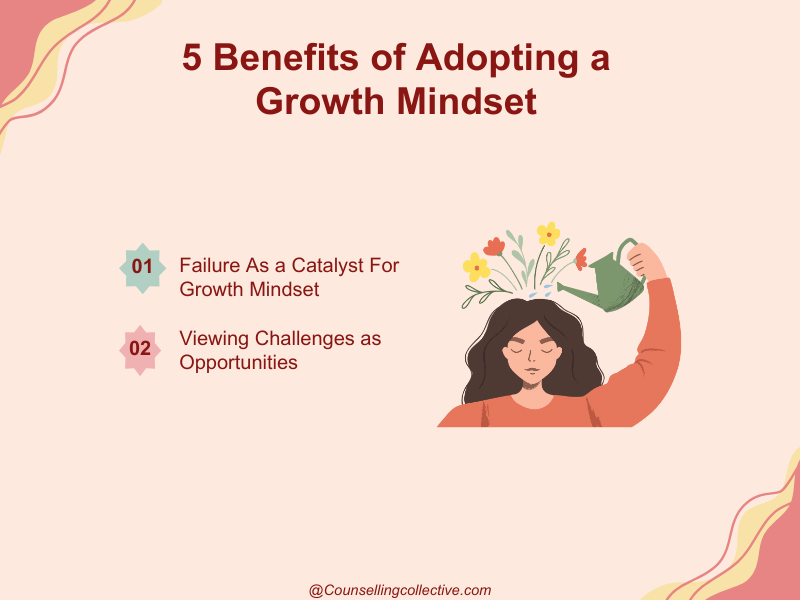
The benefits of a growth mindset are extensive:
| Increased Resilience | Viewing challenges as opportunities for growth helps individuals bounce back from setbacks. |
| Enhanced Learning | Focusing on effort and strategies leads to continuous improvement and skill development |
| Improved Relationships | A growth mindset fosters empathy and understanding, enhancing personal and professional relationships. |
| Higher Achievement | Embracing challenges and learning from failures leads to higher levels of achievement and success. |
| Development of a Growth Mindset | One of the fundamental principles supporting the growth mindset is neuroplasticity, the brain’s ability to reorganize itself by forming new neural connections throughout life |
Failure As a Catalyst For Growth Mindset
To develop a growth mindset, it is essential to embrace challenges rather than shy away from them. Challenges provide opportunities to learn and grow. Viewing failure as a natural part of the learning process is crucial. Instead of seeing failures as reflections of one’s abilities, individuals with a growth mindset analyze their mistakes, learn from them, and try again with improved strategies.
Viewing Challenges as Opportunities
Challenges are seen as opportunities for growth and learning. Individuals with a growth mindset are not afraid to step out of their comfort zones and take on difficult tasks. They understand that overcoming challenges builds strength, resilience, and competence. This approach can lead to several benefits:
- Enhanced Problem-Solving Skills: By tackling challenges head-on, you improve your ability to find creative solutions and adapt to changing circumstances.
- Increased Resilience: Embracing difficulties helps build mental toughness and resilience, preparing you for future challenges.
- Personal Growth: Facing and overcoming obstacles often leads to personal development, expanding your skills and knowledge.
- Innovation: Challenges can drive innovation by pushing you to think outside the box and explore new ideas.
- Confidence Building: Successfully navigating challenges can boost your self-confidence and belief in your abilities.
Setting Achievable and Meaningful Goals (SMART)
Setting realistic and meaningful goals helps maintain motivation and provides a clear direction for growth. These goals should be specific, measurable, attainable, relevant, and time-bound (SMART).
Breaking down large goals into smaller, manageable steps makes the process less overwhelming and allows for regular progress assessment and adjustments.

Here’s a deeper look into each aspect of this approach:
- Specific: Clearly define what you want to achieve. A specific goal has a much greater chance of being accomplished than a general one.
- For example, instead of setting a goal to “get better at math,” set a specific goal to “improve my algebra skills by practicing for 30 minutes every day.”
- Measurable: Establish criteria for measuring progress toward the attainment of each goal you set. This helps you stay on track, reach your target dates, and experience the exhilaration of achievement that spurs you on to the continued effort required to reach your goals.
- For example, you can measure progress in learning algebra by tracking the number of practice problems completed correctly.
- Attainable: Ensure that your goals are realistic and achievable. Setting overly ambitious goals can be discouraging and counterproductive. An attainable goal should stretch your abilities but still remain possible.
- For example, if you currently struggle with algebra, it might not be realistic to aim for perfect scores immediately, but improving your test scores by a certain percentage over a semester is more attainable.
- Relevant: Your goals should matter to you and align with other relevant goals. A goal that supports or is in alignment with other goals would be considered relevant.
- For example, improving algebra skills is relevant if it is necessary for passing a math class or pursuing a career that requires mathematical proficiency.
- Time-bound: A time-bound goal has a specific deadline, creating a sense of urgency and helping to focus efforts. It answers the question of when.
- Example: “I will complete my 5K training and run the marathon by September 30th, giving me three months to prepare.
Breaking down large goals into smaller, manageable steps makes the process less overwhelming and allows for regular progress assessment and adjustments. This approach not only makes it easier to achieve long-term objectives but also provides frequent opportunities to celebrate small victories, keeping you motivated and focused on continual growth and improvement.
Resilience As a Source For Growth Mindset
| Aspect | Description |
| Building a Positive Attitude Toward Challenges | Develop a positive outlook on challenges by viewing them as growth opportunities. Embrace setbacks as part of the learning process with optimism. |
| Practicing Mindfulness | Engage in mindfulness practices like meditation and mindful breathing to enhance self-awareness and reduce stress. Helps maintain a balanced perspective. |
| Maintaining Positive Self-Talk | Use affirmations and supportive language to encourage yourself and reframe negative thoughts into constructive ones. Reinforces belief in perseverance. |
| Seeking Support from Others | Build a network of friends, mentors, or colleagues for encouragement and advice. Collaborate to navigate challenges and enhance resilience. |
| Commitment to Continuous Effort | Set incremental goals and stay dedicated to your objectives. Regularly assess progress and maintain effort even in the face of difficulties or slow progress. |
Fostering a Love for Learning and Self-Improvement
A love for learning and self-improvement is a hallmark of a growth mindset. Individuals are curious, motivated to learn new things, and constantly seek ways to enhance their abilities. This intrinsic motivation drives continuous development and personal growth.
Impact of Growth Mindset on Your Personal and Professional Life
A growth mindset significantly impacts academic and career success. Students with a growth mindset are more likely to embrace challenges, persist through difficulties, and achieve higher academic performance in educational settings.
In the workplace, a growth mindset promotes continuous learning, adaptability, and innovation, leading to career advancement and professional fulfillment.
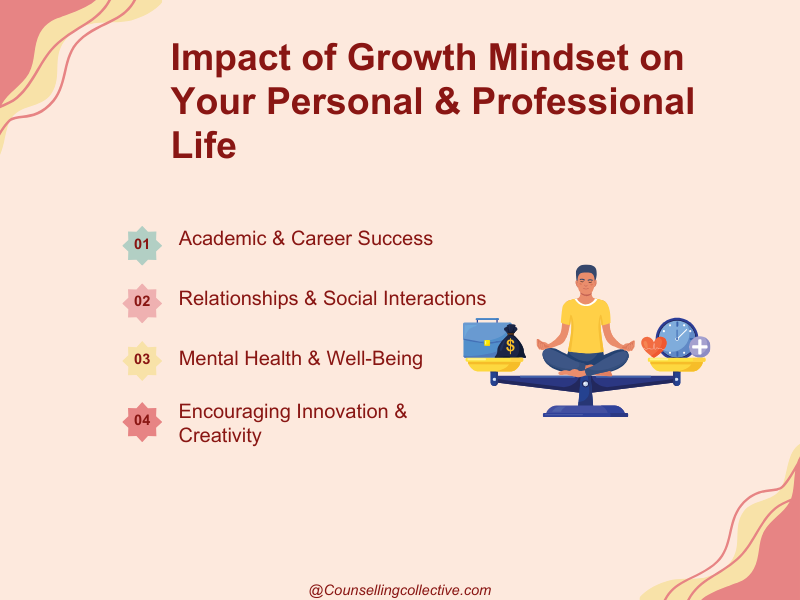
- Improving Relationships and Social Interactions: A growth mindset can enhance relationships and social interactions. It fosters empathy, understanding, and effective communication. Individuals with a growth mindset are more open to feedback, willing to resolve conflicts constructively, and supportive of others’ growth. This leads to healthier, more fulfilling relationships.
- Boosting Mental Health and Well-Being: Adopting a growth mindset positively affects mental health and well-being. It reduces the fear of failure and the stress associated with perfectionism. A focus on learning and growth rather than on fixed abilities encourages a more positive and resilient outlook. This mindset promotes self-compassion, reduces anxiety, and enhances overall well-being.
- Encouraging Innovation and Creativity: A growth mindset encourages innovation and creativity. By embracing challenges and viewing failures as learning opportunities, individuals are more likely to experiment with new ideas and approaches. This openness to innovation fosters creativity and leads to the development of unique solutions and advancements.
The upcoming section of this article will discuss practical strategies for implementing a growth mindset in various settings, including educational environments and workplaces.
It will cover techniques for fostering a growth-oriented culture, offering effective feedback, celebrating incremental progress, and modeling growth mindset behaviors. This will provide actionable insights for cultivating a supportive atmosphere that encourages continuous learning and development.
Comparison of People with Fixed vs. Growth Mindset
The concept of mindset, as introduced by psychologist Carol Dweck, divides individuals into two primary categories: those with a fixed mindset and those with a growth mindset. This comparison explores the behaviors and attitudes of individuals with these mindsets in various aspects of life, including education and professional settings.
Students
| Fixed Mindset: Behavior: A student with a fixed mindset believes that their intelligence and abilities are static traits that cannot be changed. They may avoid challenging tasks, fear failure, and feel threatened by others’ success. | Growth Mindset: Behavior: A student with a growth mindset believes that abilities can be developed through effort and learning. They embrace challenges, view failures as opportunities for growth, and seek feedback to improve. |
| Real-Life Example: Alex consistently avoids advanced classes and complex assignments because they fear they won’t succeed. When faced with difficult problems, Alex may give up quickly or not try at all, believing that effort is pointless if they are not naturally talented. | Real-Life Example: Jamie eagerly takes on challenging projects and persistently works through difficulties. When they struggle with a subject, they seek help, use resources, and view setbacks as a part of the learning process, ultimately leading to improvement and resilience. |
Professionals
| Fixed Mindset: Behavior: A professional with a fixed mindset might avoid taking on new projects or roles that involve uncertainty or potential failure. They may focus on proving their existing abilities rather than developing new skills and can become defensive when receiving criticism. | Growth Mindset: Behavior: A professional with a growth mindset is open to new challenges and is proactive in developing their skills. They view feedback as a valuable tool for improvement and are willing to take calculated risks to advance their career. |
| Real-Life Example: Sam avoids leading innovative initiatives at work, preferring to stick to routine tasks. When their ideas are criticized, they react defensively rather than using the feedback constructively, which can hinder their career growth and adaptability. | Real-Life Example: Taylor actively seeks opportunities for professional development and embraces new projects, even if they come with risks. They welcome constructive criticism and use it to refine their skills and strategies, contributing to their long-term success and leadership in the organization. |
Growth Mindset in Psychology
A growth mindset, a concept popularized by psychologist Carol Dweck, refers to the belief that abilities and intelligence can be developed through effort and learning.
In psychology, this mindset contrasts with a fixed mindset, which views traits as static and unchangeable. Embracing a growth mindset encourages resilience, adaptive learning, and personal development across various domains.
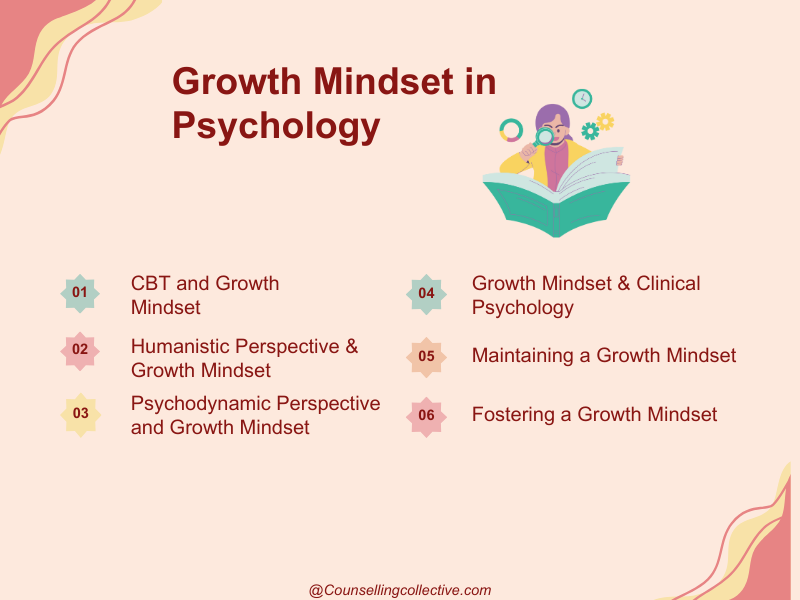
CBT and Growth Mindset
Cognitive Behavioral Therapy (CBT) aligns closely with the principles of a growth mindset. CBT focuses on identifying and changing negative thought patterns and behaviors, promoting the idea that our thoughts can be altered to improve our emotional and behavioral responses. In the context of a growth mindset:
- Challenge and Change: CBT encourages individuals to challenge their fixed beliefs and adopt more flexible, growth-oriented thinking.
- Resilience Building: By reframing negative thoughts and embracing a learning attitude, CBT helps individuals build resilience and a willingness to embrace challenges, akin to a growth mindset.
Humanistic Perspective and Growth Mindset
The humanistic perspective in psychology, championed by theorists like Carl Rogers and Abraham Maslow, emphasizes personal growth, self-actualization, and the inherent potential for individuals to develop and improve. This perspective is closely related to the growth mindset:
- Self-Actualization: Humanistic psychology focuses on the idea that individuals have the potential to grow and achieve their fullest potential, reflecting the core principles of a growth mindset.
- Unconditional Positive Regard: Carl Rogers’ concept of unconditional positive regard supports the idea that people can grow and change when they feel accepted and valued, aligning with the growth mindset’s emphasis on learning from experiences without fear of judgment.
Psychodynamic Perspective and Growth Mindset
The psychodynamic perspective, rooted in the work of Sigmund Freud and his successors, focuses on unconscious processes and early life experiences shaping behavior. While traditionally more aligned with fixed traits, certain aspects of psychodynamic theory can intersect with the growth mindset:
- Insight and Change: Psychodynamic therapy encourages gaining insight into one’s unconscious motivations and conflicts, which can lead to personal change and growth, similar to the growth mindset’s focus on developing abilities through effort and understanding.
- Understanding and Adaptation: By exploring past experiences and unconscious processes, individuals can develop a better understanding of themselves, potentially fostering a growth mindset approach to personal development.
Growth Mindset & Clinical Psychology
In clinical psychology, the growth mindset is often integrated into cognitive-behavioral therapy (CBT).
CBT focuses on changing negative thought patterns and behaviors, and promoting a growth mindset can enhance these therapeutic efforts. Clients are encouraged to reframe their perceptions of challenges and failures, recognizing their potential for growth and change.
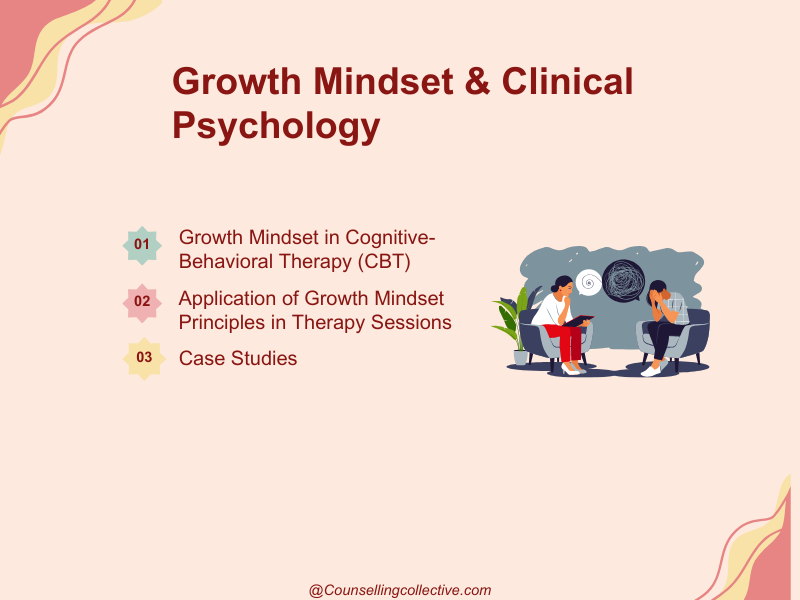
Humanistic theories, such as Maslow’s hierarchy of needs, emphasize self-actualization and personal growth. A growth mindset aligns with these principles by encouraging individuals to strive for their full potential. Maslow’s theory suggests that once basic needs are met, individuals are motivated to pursue growth and self-improvement, which is the essence of a growth mindset.
How to maintain a Growth Mindset
Self-reflection and mindfulness are powerful tools for maintaining a growth mindset. Regular self-reflection helps individuals evaluate their progress, identify areas for improvement, and celebrate successes.
Mindfulness practices, such as meditation and mindful breathing, enhance self-awareness and help individuals stay present, reducing stress and promoting a positive mindset.
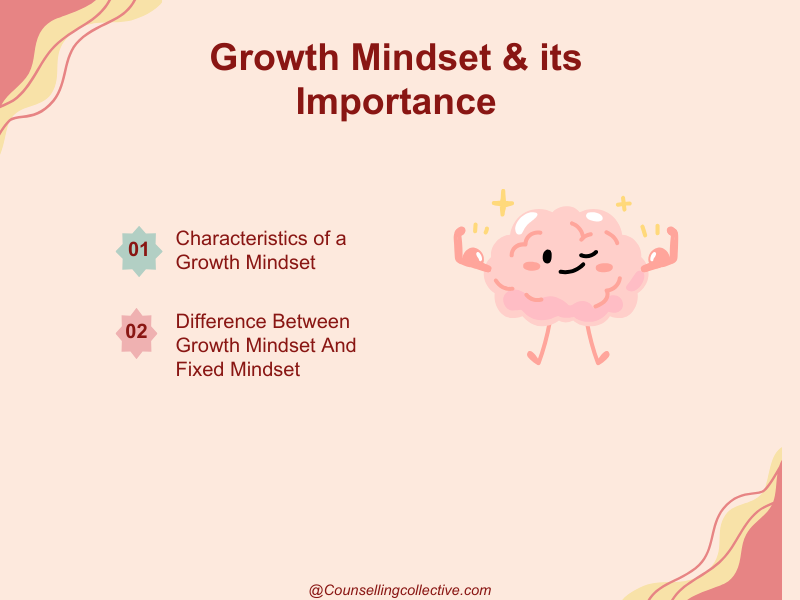
- Embrace Challenges: View challenges as opportunities to learn and grow rather than as obstacles. Tackling difficult tasks head-on can help you build resilience and develop new skills.
- Learn from Criticism: Constructive feedback is a valuable tool for improvement. Instead of taking criticism personally, see it as a chance to gain insights and enhance your performance.
- Celebrate Effort and Progress: Focus on the effort you put into achieving your goals rather than solely on the outcome. Acknowledge and celebrate small wins and progress along the way.
- Cultivate Curiosity: Stay curious and open-minded. Ask questions, seek out new knowledge, and explore different perspectives. Curiosity drives continuous learning and growth.
How to foster a Growth Mindset
Fostering a growth mindset in others begins with encouraging a culture of learning and growth. Create environments where curiosity, experimentation, and continuous improvement are valued.
- Model a Growth Mindset: Demonstrate your own commitment to learning and improvement. Share your experiences of overcoming challenges and learning from failures. Your behavior can serve as a powerful example.
- Provide Constructive Feedback: Offer feedback that focuses on effort, strategies, and progress rather than fixed traits or outcomes. Encourage others by highlighting their strengths and providing specific, actionable suggestions for improvement.
- Encourage a Focus on Learning: Shift the emphasis from solely achieving results to valuing the learning process. Celebrate efforts, problem-solving, and creative thinking, not just the end result.
Finding the Right Mental Health Support
Explore our comprehensive resources on therapy modalities, mental health conditions, and self-care strategies. Whether you’re interested in cognitive-behavioral therapy or seeking guidance on managing anxiety, we empower you to make informed decisions about your mental health care. We’re here to support you in finding the right therapist and achieving a healthier, happier life.
Conclusion
Adopting a growth mindset can transform both personal and professional aspects of life by fostering resilience, enhancing learning, and encouraging continuous improvement. By embracing challenges, viewing failures as learning opportunities, and cultivating a love for learning, individuals can unlock their full potential.
Integrating growth mindset principles into therapy and daily interactions promotes mental well-being, innovation, and stronger relationships. Committing to this mindset empowers individuals to overcome obstacles and achieve greater success in all areas of life.
References
[1] Dweck, C. S. (2006). Mindset: The new psychology of success. Random House. Amazon
[2] Rogers, C. R. (1961). On becoming a person: A therapist’s view of psychotherapy. Houghton Mifflin. Amazon
[3] Maslow, A. H. (1970). Motivation and personality. Harper & Row.
[4] Seligman, M. E. P. (1991). Learned optimism: How to change your mind and your life. Knopf. Amazon
[5] Bandura, A. (1997). Self-efficacy: The exercise of control. W. H. Freeman. Amazon
[6] Beck, A. T. (1979). Cognitive therapy of depression. Guilford Press. Amazon
[7] Ellis, A. (1962). Reason and emotion in psychotherapy. Lyle Stuart. Amazon
[8] Dweck, C. S., & Yeager, D. S. (2019). Mindsets that promote resilience: When students believe that personal characteristics can be developed. Perspectives on Psychological Science, 14(4), 481-490. Amazon
[9] Psychological Science, 14(4), 481-490. McAdams, D. P. (2006). The person: An introduction to the science of personality psychology. Wiley. Amazon
[10] Pink, D. H. (2009). Drive: The surprising truth about what motivates us. Riverhead Books. Amazon
